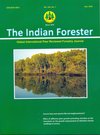Reproduction and Conservation of Taxus baccata in Uttarakhand
DOI:
https://doi.org/10.36808/if/2016/v142i7/99339Abstract
No Abstract.References
Anon. (1976). The Wealth of India. Publication and Information Directorate. CSIR new Delhi Vol X. 591 pp
Balakrishnamurthy G. and Rao V.N.M. (1989). Influence of IBA and season on clonal multiplication of Edward rose (Rosa bourboriana Desp.). Res. Develop. Rep., 6, 92-102.
Chee P.P. (1994). In-vitro culture of zygotic embryos of Taxus species by thiamine. Plant Cell Rep., 14: 753-757.
Ewald D., Stauber T. and Zocher R. (2002). Evaluation and selection of Taxus baccata L. clones according to their root growth capacity as a potential source of enzymes for Taxol biosynthesis. Silvae Gen., 51: 133-136.
Garcia D., Zamara R., Hodar J.A. , Gomez J.M. and Castro J. (2000). Yew (Taxus baccata L.) regeneration is facilitated by fleshy fruited shrubs in Mediterranean environments. Biol. Con., 95: 31-38.
Gaur R.D. (1999). Flora of the District Garhwal North West Himalaya. Trans media, Srinagar (Garhwal), India. 811 pp
Heller A., Borochov A. and Halevy A.H. (1984). Factors affecting rooting ability of Coleonema aspalanthoides. Sci. Hort. 58: 335-341.
Majada J.P., Sierra M.L. and Sanchez - Tames R. (2000). One step more towards taxane production through enhanced Taxus propagation. Plant Cell Rep., 19: 825-830.
Purohit A., Maikhuri R.K., Rao K.S. and Nautiyal S. (2001). Impact of bark removal on survival of Taxus baccata L. (Himalayan Yew) in Nanda Devi Biosphere Reserve, Garhwal Himalaya, India. Curr. Sci., 81 (5): 586-590.
Shin H.K., Chon C.K. and Choi S.T. (1988). Seasonal changes in the rooting ablity of herbaceous cuttings of Gypsophilia paniculata L. cv. Bristal Fairy. J. Kor. Soc. Hor. Sci., 29: 319-327.
Downloads
Downloads
Published
How to Cite
Issue
Section
License
Unless otherwise stated, copyright or similar rights in all materials presented on the site, including graphical images, are owned by Indian Forester.





